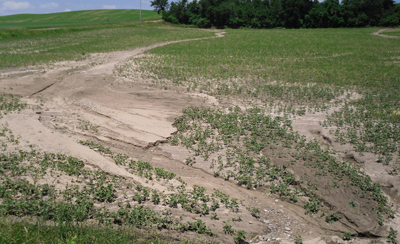By Mike Staton, Michigan State University Extension
Producers are looking for ways to improve the quality and productivity of their soils. While this is important, keeping the existing soil quality and productivity from degrading due to soil erosion is just as important. This is especially true given the frequent and intense rain events we’ve experienced in recent years.
Well designed and maintained grassed waterways can be an important tool for maintaining soil quality and productivity. The field shown in Photos 1 and 2 is an excellent example. Photo 1 was taken after a heavy rain event in June of 2010. The producer responded to this situation by establishing the grassed waterway shown in Photo 2.

Photo 1: Severe soil erosion and sediment deposition (2010).

Photo 2: Successfully established and maintained grassed waterway (2015).
There are two main complaints I hear about grassed waterways:
- They are difficult to establish (Photo 3) and
- Over time, the water runs around waterways instead of through them (Photo 4).
Both of these challenges can be overcome.

Photo 3: Newly seeded waterway washed out by spring and summer rain events (2015).

Photo 4: Water flowing around an established waterway due to sediment accumulation (2010).
Michigan State University Extension advises that the best time to establish waterways is following wheat harvest. The wheat stubble stabilizes the surrounding soil and the grass will have good conditions for germination and adequate time to become established beforethe fall rains. The waterway shown in Photo 3 was established this spring and was washed out by one or more intense rainfall events. Straw bales were placed across the waterway to prevent this. However, they did not work in this situation and are not recommended.
There are two reasons why water runs around waterways rather than through them. First, sediment builds up in the waterway to the point that the waterway becomes higher than the surrounding soil (Photo 4). Proper design will eliminate this problem. Tillage and planting operations performed parallel to the waterways rather than perpendicular to them can also cause water to flow around waterways. All tillage and planting operations should be directed into grassed waterways and never around them.
General recommendations for establishing grassed waterways include:
- Locate grassed waterways in areas of concentrated water flow.
- Establish grassed waterways after wheat harvest.
- Select a mixture of sod-forming grasses such as creeping red fescue, tall fescue, Kentucky blue grass, smooth brome and perennial ryegrass.
- Make the cross section of the waterway either trapezoidal or parabolic, and never V-shaped.
- Be sure waterways are at least 0.8 of a foot deep and the slope of the sidewalls should never be steeper than 1 foot of rise for every 3 feet of run.
- Never install rocks, straw bales etc. that extend above the floor of the waterway.
The USDA Natural Resource Conservation Service (NRCS) is the best source of information regarding soil conservation practices including grassed waterways. In some situations, cost share funds and site-specific assistance will be provided to producers. However, due to existing workloads, there may be a waiting period for cost-shared waterways to be designed and installed. The NRCS has online resources available at www.mi.nrcs.usda.gov for producers who want to install waterways on their own. The following NRCS resources are recommended:
- NRCS Technical Guide: Grassed Waterways 412
- NRCS Technical Guide: Critical Area Planting 342
- Grassed Water way Cross Sections
These materials cover waterway design, grass species selection and waterway maintenance. Producers should review these materials and contact their local NRCS office for a brief consultation before installing a grassed waterway.
Source:msu.edu